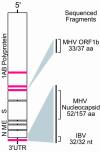Viral discovery and sequence recovery using DNA microarrays
- PMID: 14624234
- PMCID: PMC261870
- DOI: 10.1371/journal.pbio.0000002
Viral discovery and sequence recovery using DNA microarrays
Abstract
Because of the constant threat posed by emerging infectious diseases and the limitations of existing approaches used to identify new pathogens, there is a great demand for new technological methods for viral discovery. We describe herein a DNA microarray-based platform for novel virus identification and characterization. Central to this approach was a DNA microarray designed to detect a wide range of known viruses as well as novel members of existing viral families; this microarray contained the most highly conserved 70mer sequences from every fully sequenced reference viral genome in GenBank. During an outbreak of severe acute respiratory syndrome (SARS) in March 2003, hybridization to this microarray revealed the presence of a previously uncharacterized coronavirus in a viral isolate cultivated from a SARS patient. To further characterize this new virus, approximately 1 kb of the unknown virus genome was cloned by physically recovering viral sequences hybridized to individual array elements. Sequencing of these fragments confirmed that the virus was indeed a new member of the coronavirus family. This combination of array hybridization followed by direct viral sequence recovery should prove to be a general strategy for the rapid identification and characterization of novel viruses and emerging infectious disease.
Conflict of interest statement
The authors have declared that no conflicts of interest exist.
Figures


Similar articles
-
Design of microarray probes for virus identification and detection of emerging viruses at the genus level.BMC Bioinformatics. 2006 Apr 28;7:232. doi: 10.1186/1471-2105-7-232. BMC Bioinformatics. 2006. PMID: 16643672 Free PMC article.
-
Tracking the evolution of the SARS coronavirus using high-throughput, high-density resequencing arrays.Genome Res. 2004 Mar;14(3):398-405. doi: 10.1101/gr.2141004. Genome Res. 2004. PMID: 14993206 Free PMC article.
-
[SARS-associated coronavirus gene fragments were detected from a suspected pediatric SARS patient].Zhonghua Er Ke Za Zhi. 2003 Sep;41(9):641-4. Zhonghua Er Ke Za Zhi. 2003. PMID: 14733796 Chinese.
-
From genome to antivirals: SARS as a test tube.Drug Discov Today. 2005 Mar 1;10(5):345-52. doi: 10.1016/S1359-6446(04)03320-3. Drug Discov Today. 2005. PMID: 15749283 Free PMC article. Review.
-
[Resequencing microarrays: a rapid tool for better identification and understanding of viral and bacterial emergence].Bull Acad Natl Med. 2013 Dec;197(9):1669-82. Bull Acad Natl Med. 2013. PMID: 26137813 Review. French.
Cited by
-
Functional genomics as a tool in virus research.Indian J Microbiol. 2008 Jun;48(2):195-201. doi: 10.1007/s12088-008-0032-3. Epub 2008 Jul 27. Indian J Microbiol. 2008. PMID: 23100713 Free PMC article.
-
Genomic approaches to studying the human microbiota.Nature. 2012 Sep 13;489(7415):250-6. doi: 10.1038/nature11553. Nature. 2012. PMID: 22972298 Free PMC article. Review.
-
Target-dependent enrichment of virions determines the reduction of high-throughput sequencing in virus discovery.PLoS One. 2015 Apr 8;10(4):e0122636. doi: 10.1371/journal.pone.0122636. eCollection 2015. PLoS One. 2015. PMID: 25853649 Free PMC article.
-
Molecular Characterization and Seroprevalence in Pigs of SC0806, a Cat Que Virus Isolated from Mosquitoes in Sichuan Province, China.Vector Borne Zoonotic Dis. 2015 Jul;15(7):423-31. doi: 10.1089/vbz.2014.1767. Vector Borne Zoonotic Dis. 2015. PMID: 26186514 Free PMC article.
-
Detection of respiratory viruses and subtype identification of influenza A viruses by GreeneChipResp oligonucleotide microarray.J Clin Microbiol. 2007 Aug;45(8):2359-64. doi: 10.1128/JCM.00737-07. Epub 2007 Jun 6. J Clin Microbiol. 2007. PMID: 17553978 Free PMC article.
References
-
- Chang Y, Cesarman E, Pessin MS, Lee F, Culpepper J, et al. Identification of herpesvirus-like DNA sequences in AIDS-associated Kaposi's sarcoma. Science. 1994;266:1865–1869. - PubMed
-
- Choo QL, Kuo G, Weiner AJ, Overby LR, Bradley DW, et al. Isolation of a cDNA clone derived from a blood-borne non-A, non-B viral hepatitis genome. Science. 1989;244:359–362. - PubMed
-
- Jonassen CM, Jonassen TO, Grinde B. A common RNA motif in the 3′ end of the genomes of astroviruses, avian infectious bronchitis virus and an equine rhinovirus. J Gen Virol. 1998;79:715–718. - PubMed
-
- Kellam P. Molecular identification of novel viruses. Trends Microbiol. 1998;6:160–165. - PubMed
-
- Ksiazek TG, Erdman D, Goldsmith CS, Zaki SR, Peret T, et al. A novel coronavirus associated with severe acute respiratory syndrome. N Engl J Med. 2003;348:1953–1966. - PubMed
Publication types
MeSH terms
LinkOut - more resources
Full Text Sources
Other Literature Sources
Molecular Biology Databases
Miscellaneous

